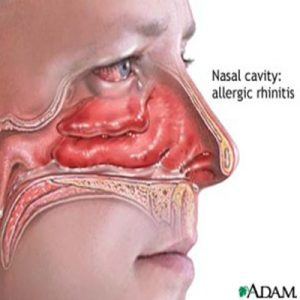 Allergic rhinitis is an inflammatory response of the nasal passages to pollens that happens through an IgE mechanism. Visually, IgE molecules are like two telephone poles strung on a mast cell. These molecules release chemicals – including histamine, bradykinins and leukotrienes – when they connect to a pollen particle, which causes allergic symptoms. Symptoms can include nasal stuffiness, runny nose, sneezing, itching, and breathing difficulty. Pollens are a common cause of nasal allergies but pet dander may also cause similar symptoms. Determining the allergen that is causing a patient’s symptoms is a key step as it will help to determine the timing of medication and strategies for avoiding allergens.
Allergic rhinitis is an inflammatory response of the nasal passages to pollens that happens through an IgE mechanism. Visually, IgE molecules are like two telephone poles strung on a mast cell. These molecules release chemicals – including histamine, bradykinins and leukotrienes – when they connect to a pollen particle, which causes allergic symptoms. Symptoms can include nasal stuffiness, runny nose, sneezing, itching, and breathing difficulty. Pollens are a common cause of nasal allergies but pet dander may also cause similar symptoms. Determining the allergen that is causing a patient’s symptoms is a key step as it will help to determine the timing of medication and strategies for avoiding allergens.
In the spring in the northeast tree pollens usually arrive in March and last until mid-May. Grass pollens are most prominent from mid-May until mid-July; and ragweed pollen, in September. Mold pollen occurs throughout the year. Pollens tend to pollinate between the hours of 6 a.m. and 10 a.m. Dust mites also occur throughout the year when humidity exceeds forty percent. Avoiding exposure during these months and hours of the day can help reduce symptoms. Any medication will be directed towards those times.
Prolonged exposure to indoor pets such as cats or dogs can lead to symptoms that last all year round. Pets usually leave excessive dander in the bedroom. Patients sleep in the bedroom for eight hours a night and are exposed to pet dander at one hundred times the amount of exposure to pollens, which may only last for six weeks. Also, New York City apartments tend to be one-third the size of homes in the rest of the United States, giving dander less places to hide. This makes avoidance with pet allergies particularly difficult and may require those with severe allergies to live pet free. Those with less severe allergies should look into vacuum cleaners with HEPA filters to help reduce build up of pet dander and keep their air clear.
Environmental controls can be done to decrease the pet and dust mite exposure. Use of dust mite covers on the bedding, and taking the carpet up in the bedroom, can decrease the presence of dust mites. Dust mite covers must be washed above 140 degrees to be effective. Use of Allerpet and air filters can significantly decrease pet dander in the bedroom. However, an air filter is ineffective against dust mites, as they are larger than cat dander and usually settle on surfaces, without staying airborne long enough to be filtered by a machine.
Air conditioning is the best treatment for filtering early morning pollination. Complications of nasal allergies can include acute or chronic sinusitis, acute sinusitis and bronchial asthma. These diseases are indications for immunotherapy which can prevent the development of these conditions.


No Comments